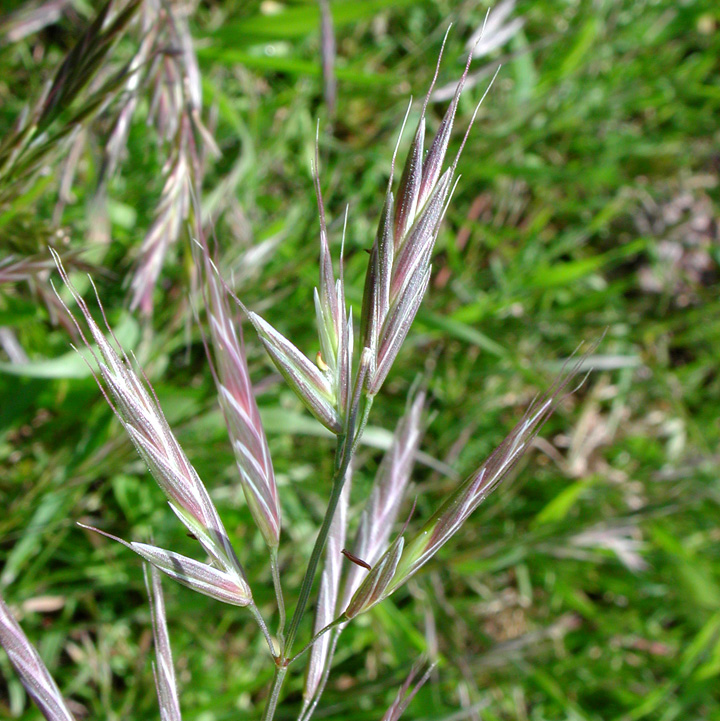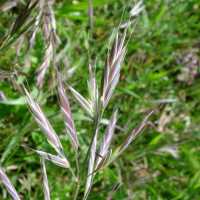Plants annual; tufted. Culms 30-90 cm tall, to 3 mm thick, erect. Sheaths retrorsely pilose, sometimes mostly glabrous, throats sometimes with hairs; auricles absent; ligules 1-4 mm, usually glabrous, obtuse, erose; blades 8-18 cm long, 3-9 mm wide, flat, sparsely pilose on both surfaces or the abaxial surfaces glabrous. Panicles 12-25 cm, somewhat contracted or open; lower branches shorter than 10 cm, 2-3(5) per node, initially erect to ascending, spreading at maturity, with 1-2 spikelets variously distributed. Spikelets 18-25 mm, elliptic to lanceolate, strongly laterally compressed, with 4-8 florets. Glumes subequal, smooth or scabrous; lower glumes 8-12.5 mm, 3-veined; upper glumes 9.5-14 mm, 7-veined, about as long as the lowest lemma; lemmas 9.5-14 mm, lanceolate, laterally compressed, prominently 7-veined, strongly keeled at least distally, glabrous or pubescent distally or throughout, marginal hairs, if present, longer than those elsewhere, apices entire or with acute teeth shorter than 1 mm; awns 6-13 mm, sometimes slightly geniculate; anthers 0.4-0.5 mm. 2n = 84.
Bromus arizonicus grows in dry, open areas and disturbed ground of the southwest, usually below 2000 m. Its range extends from California and southern Nevada into Arizona, New Mexico, Colorado, and northern Mexico.
Stebbins et al. (1944) demonstrated that, like Bromus carinatus, B. arizonicus obtained three of its genomes from B. catharticus-or a close relative, but the remaining three genomes are not homologous with those in B. carinatus, probably being derived from a species in a section other than Ceratochloa. The small anthers of B. arizonicus strongly suggest that most seed is produced by selfing.
Common Name: Arizona brome
Duration: Annual
Nativity: Native
Lifeform: Graminoid
General: Tufted annual grass with erect stems 30-90 cm tall, to 3 mm thick.
Vegetative: Sheaths retrorsely pilose, the throats sometimes with hairs; ligule 1-4 mm, obtuse, irregularly toothed, usually glabrous; blades flat, thin, 8-18 cm long by 3-9 mm broad, sparsely pilose on both surfaces, or the under-surface glabrous.
Inflorescence: Somewhat contracted to open panicles 12-25 cm, lower branches 2-3 per node, each shorter than 10 cm, initially erect to ascending, spreading at maturity with 1-2 spikelets per branch; spikelets 18-25 mm, elliptic to lanceolate, strongly laterally compressed, with 4-8 florets; subequal glumes, smooth to scabrous; upper glume 7-veined, about as long as lowest lemma; lemmas 9-14 mm, lanceolate, laterally compressed, prominently 7-veined, strongly keeled at least distally, glabrous or pubescent; marginal hairs of lemma, if present, longer than those elsewhere; lemma apices entire or with acute teeth shorter than 1 mm; awns 6-13 mm from the back of the lemma.
Ecology: Found in dry, open sites often along sandy washes and on disturbed sites below 6,500 ft (1981 m); flowers March-June.
Distribution: AZ, NM, s CA, s NV, s CO, south to n MEX
Notes: Closely related genetically to B. catharticus and nearly indistinguishable from B. carinatus and B. marginatus. All four of these species belong to a section Ceratochloa in the Bromus genus, with spikelets that are strongly flattened and lemmas that are strongly keeled, forming a V shape in median cross section. B. arizonicus is distinguished from B. catharticus by having awns 6-13 mm long; B. catharticus is unawned or has tiny awns less than 4 mm. Differences between B. arizonicus, B. carinatus, and B. marginatus are more subtle and difficult to see without a hand lens or microscope. In some treatments, the 3 taxa are considered to be varieties of the same species (B. carinatus). B. arizonicus most similar to B. carinatus; B. arizonicus is a low elevation (<5,000 ft) annual, while B. carinatus has a wide range and can be an annual or biennial, and B. marginatus is a higher elevation perennial. B. arizonicus has scabrous lemmas which are often (but not always) ciliate pubescent on the margins and have 7 prominent veins; also the glumes are large, the upper glume nearly equalling the length of the lowest lemma. B. carinatus and B. marginatus both have glumes that are definitely shorter than the first lemma. B. carinatus has lemmas that are more or less uniformly pubescent, sometimes scabrous, with 7 less prominent veins. B. marginatus has lemmas that can be glabrous, evenly pubescent, or pubescent on the margins only, with 7-9 less prominent veins.
Ethnobotany: Unknown
Etymology: Bromus is from Greek bromo, for stinking, while arizonicus means of or from Arizona.
Synonyms: None
Editor: SBuckley 2010, AHazelton 2015




